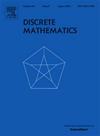酉加法凯莱图的色差数和消色差数
IF 0.7
3区 数学
Q2 MATHEMATICS
引用次数: 0
摘要
设R是一个环。R的酉加法Cayley图,记为U(R),是顶点为R的图,当且仅当x+y是一个单位时,两个不同的顶点x和y相邻。当R是一个元素个数为奇数的有限交换环时,给出了图的团数和色数的公式。这包括特殊情况,当R是Zn,整数对n取模,这些参数是在假设n是偶数,或者n是奇数素数的幂的情况下得到的。此外,我们还研究了n为两个素数积时U(Zn)的消色差数。证明了当q>;3为素数时,U(Z3q)的消色差数等于3q+12。我们还证明了当n=pq时的下界,其中p和q是不同的奇素数。本文章由计算机程序翻译,如有差异,请以英文原文为准。
Chromatic and achromatic numbers of unitary addition Cayley graphs
Let R be a ring. The unitary addition Cayley graph of R, denoted , is the graph with vertex R, and two distinct vertices x and y are adjacent if and only if is a unit. We determine a formula for the clique number and chromatic number of such graphs when R is a finite commutative ring with an odd number of elements. This includes the special case when R is , the integers modulo n, where these parameters had been found under the assumption that n is even, or n is a power of an odd prime. Additionally, we study the achromatic number of in the case that n is the product of two primes. We prove that the achromatic number of is equal to when is a prime. We also prove a lower bound that applies when where p and q are distinct odd primes.
求助全文
通过发布文献求助,成功后即可免费获取论文全文。
去求助
来源期刊

Discrete Mathematics
数学-数学
CiteScore
1.50
自引率
12.50%
发文量
424
审稿时长
6 months
期刊介绍:
Discrete Mathematics provides a common forum for significant research in many areas of discrete mathematics and combinatorics. Among the fields covered by Discrete Mathematics are graph and hypergraph theory, enumeration, coding theory, block designs, the combinatorics of partially ordered sets, extremal set theory, matroid theory, algebraic combinatorics, discrete geometry, matrices, and discrete probability theory.
Items in the journal include research articles (Contributions or Notes, depending on length) and survey/expository articles (Perspectives). Efforts are made to process the submission of Notes (short articles) quickly. The Perspectives section features expository articles accessible to a broad audience that cast new light or present unifying points of view on well-known or insufficiently-known topics.
 求助内容:
求助内容: 应助结果提醒方式:
应助结果提醒方式:


